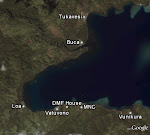From Seewah’s house we drove to the water storage tank in Buca. The tank is located at the side of the road, uphill from a small graveyard. We observed the existing slow sand filtration system that was put in by the DMF just last year, and is currently bypassed due to volume constraints. This was just a quick visit and we plan to return later to take more photos and measurements. In the village we were introduced to Amose, the deputy Headman. Apparently in Buca there is a village chief who is appointed by lineage and a separate Headman who is elected every two years from one of four clans in the village. We gave a short spiel to Amose about EWB’s intentions and was given permission to access the village.
Next we drove to Vunikura and were introduced to Headman Titimo,  head of the Taqici tribe. (The village chief “William” was out of town.) Vunikura’s water system operators Arone and Pele accompanied us up to visit the water source for their village. This source was a bit of a hike through dense tropical foliage. Again, we promised to return for more photos and samples.
head of the Taqici tribe. (The village chief “William” was out of town.) Vunikura’s water system operators Arone and Pele accompanied us up to visit the water source for their village. This source was a bit of a hike through dense tropical foliage. Again, we promised to return for more photos and samples.
We made a quick stop to meet Sunny, an indo-Fijian who runs the local “Costco”, which turned out to be a mechanics yard and small supply store. (For readers who don’t know, Fiji is made up of two cultures – indigenous Fijians and Indo-Fijians who descend from the time of British colonization.) We then met Cemelle (which sounds an awful lot like “Smelly” to us), who is the water system operator for Loa. We arranged with Cemelle to meet with his village chief on Monday morning at 8 am, Fijian time of course!
Following a successful skype meeting with our EWB team back  home, we schlepped back to Vunikura with Seewah as our guide, to take samples at the village taps. Titimo, the headman, showed us the taps. There are about 35 to 40 houses in the village and approximately 12 communal taps, although some homes have their own taps. We were told that one house even has 3 taps (although we didn’t observe this for ourselves). Justin brought the GPS system to document the location of each of the taps, and we collected four samples.
home, we schlepped back to Vunikura with Seewah as our guide, to take samples at the village taps. Titimo, the headman, showed us the taps. There are about 35 to 40 houses in the village and approximately 12 communal taps, although some homes have their own taps. We were told that one house even has 3 taps (although we didn’t observe this for ourselves). Justin brought the GPS system to document the location of each of the taps, and we collected four samples.
We quickly went to work that evening testing them for total coliforms, E. Coli, salmonella (indicator for typhoid) and turbidity in our portable water quality test kits. From there we turned in for the evening, exhausted but happy with our first day of hard work.








No comments:
Post a Comment